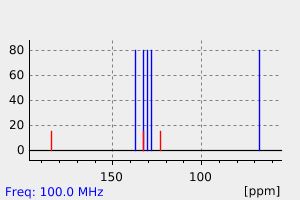1-(3-bromophenyl)-2,2-dichloroethanone | 96717-76-9
中文名称
——
中文别名
——
英文名称
1-(3-bromophenyl)-2,2-dichloroethanone
英文别名
1-m-bromophenyl-2,2-dichloro-1-ethanone;1-(3-bromophenyl)-2,2-dichloroethan-1-one
CAS
96717-76-9
化学式
C8H5BrCl2O
mdl
——
分子量
267.937
InChiKey
IFZFEXDFJOQPNR-UHFFFAOYSA-N
BEILSTEIN
——
EINECS
——
-
物化性质
-
计算性质
-
ADMET
-
安全信息
-
SDS
-
制备方法与用途
-
上下游信息
-
文献信息
-
表征谱图
-
同类化合物
-
相关功能分类
-
相关结构分类
物化性质
-
沸点:318.9±32.0 °C(Predicted)
-
密度:1.671±0.06 g/cm3(Predicted)
计算性质
-
辛醇/水分配系数(LogP):3.6
-
重原子数:12
-
可旋转键数:2
-
环数:1.0
-
sp3杂化的碳原子比例:0.12
-
拓扑面积:17.1
-
氢给体数:0
-
氢受体数:1
SDS
上下游信息
-
上游原料
中文名称 英文名称 CAS号 化学式 分子量 3'-溴苯乙酮 1-(3-Bromophenyl)ethanone 2142-63-4 C8H7BrO 199.047
反应信息
-
作为产物:参考文献:名称:A Convenient and Efficient Synthesis of 1-Aryl-2,2-dichloroethanones摘要:1-芳基乙酮可通过含水的HCl-H2O2体系与乙醇作为共溶剂的方式轻松地进行氯化反应。反应迅速进行,并且能选择性地将1-芳基乙酮转化为1-芳基-2,2-二氯乙酮,产率根据芳基团上取代基的性质不同而介于48-89%之间。DOI:10.1055/s-2004-834871
文献信息
-
Dichloroacetophenones targeting at pyruvate dehydrogenase kinase 1 with improved selectivity and antiproliferative activity: Synthesis and structure-activity relationships作者:Shao-Lin Zhang、Zheng Yang、Xiaohui Hu、Kin Yip TamDOI:10.1016/j.bmcl.2018.09.026日期:2018.11Dichloroacetophenone is a pyruvate dehydrogenase kinase 1 (PDK1) inhibitor with suboptimal kinase selectivity. Herein, we report the synthesis and biological evaluation of a series of novel dichloroacetophenones. Structure-activity relationship analyses (SARs) enabled us to identify three potent compounds, namely 54, 55, and 64, which inhibited PDK1 function, activated pyruvate dehydrogenase complex
-
Halogenation Using Quaternary Ammonium Polyhalides. XXXII. Dichlorination of Aromatic Acetyl Derivatives with Benzyltrimethylammonium Tetrachloroiodate作者:Takaaki Kakinami、Yasuaki Urabe、Irwan Hermawan、Hiroko Yamanishi、Tsuyoshi Okamoto、Shoji KajigaeshiDOI:10.1246/bcsj.65.2549日期:1992.9The reaction of aromatic acetyl derivatives with 2 molar amounts of benzyltrimethylammonium tetrachloroiodate in acetic acid at 70 °C for several hours gave dichloroacetyl derivatives in good yields.
-
Cu@CuFe2O4 nanoparticles catalyzed oxidative functionalization of alkynes: Access to α,α‐dichloro ketones作者:Huahui Wang、Sichao Wu、Xianghua Zeng、Lu ChenDOI:10.1002/aoc.7532日期:2024.8provides a foundational raw material for the subsequent synthesis of chlorinated functional molecules, which is achieved through a mild transformation of arylalkynes using readily available commercial feedstocks and exhibiting good tolerance with various substituents on the aromatic ring, including the aliphatic alkyne. This novel heterogeneous catalyst may be used in numerous industrial applications本研究通过简单的方法制备了新型Cu@CuFe 2 O 4 纳米粒子。通过利用 N-氯代琥珀酰亚胺(NCS)作为氯源和 Cu@CuFe 2 O 4 磁性纳米颗粒(NPs)作为可回收催化剂的兼容系统,我们提出了一种新颖实用的催化剂。在三氟乙醇(TFE)水溶液中直接获得芳基α,α-二氯酮的方法。催化剂被回收并重复使用多达五次,活性没有明显下降。目前的研究为随后合成氯化功能分子提供了基础原料,这是通过使用易于获得的商业原料对芳基炔进行温和转化来实现的,并且对芳环上的各种取代基(包括脂肪族炔)表现出良好的耐受性。这种新型非均相催化剂具有可回收性高、催化剂负载量要求低、成本效益高、易于处理等优点,可用于多种工业应用。
表征谱图
-
氢谱1HNMR
-
质谱MS
-
碳谱13CNMR
-
红外IR
-
拉曼Raman
-
峰位数据
-
峰位匹配
-
表征信息
同类化合物
(反式)-4-壬烯醛
(s)-2,3-二羟基丙酸甲酯
([1-(甲氧基甲基)-1H-1,2,4-三唑-5-基](苯基)甲酮)
(Z)-4-辛烯醛
(S)-氨基甲酸酯β-D-O-葡糖醛酸
(S)-3-(((2,2-二氟-1-羟基-7-(甲基磺酰基)-2,3-二氢-1H-茚满-4-基)氧基)-5-氟苄腈
(R)-氨基甲酸酯β-D-O-葡糖醛酸
(5,5-二甲基-2-(哌啶-2-基)环己烷-1,3-二酮)
(2,5-二氟苯基)-4-哌啶基-甲酮
龙胆苦苷
龙胆二糖甲乙酮氰醇(P)
龙胆二糖丙酮氰醇(P)
龙胆三糖
龙涎酮
齐罗硅酮
齐留通beta-D-葡糖苷酸
鼠李糖
黑芥子苷单钾盐
黑海棉酸钠盐
黑木金合欢素
黑曲霉三糖
黑介子苷
黄尿酸8-O-葡糖苷
麻西那霉素II
麦迪霉素
麦芽糖脎
麦芽糖基海藻糖
麦芽糖1-磷酸酯
麦芽糖
麦芽四糖醇
麦芽四糖
麦芽十糖
麦芽六糖
麦芽五糖水合物
麦芽五糖
麦芽五糖
麦芽五糖
麦芽三糖醇
麦芽三糖
麦芽三糖
麦芽三塘水合
麦芽七糖水合物
麦芽七糖
麦法朵
麦可酚酸-酰基-Β-D-葡糖苷酸
麦利查咪
麝香酮
鹤草酚
鸢尾酚酮 3-C-beta-D-吡喃葡萄糖苷
鸡矢藤苷







